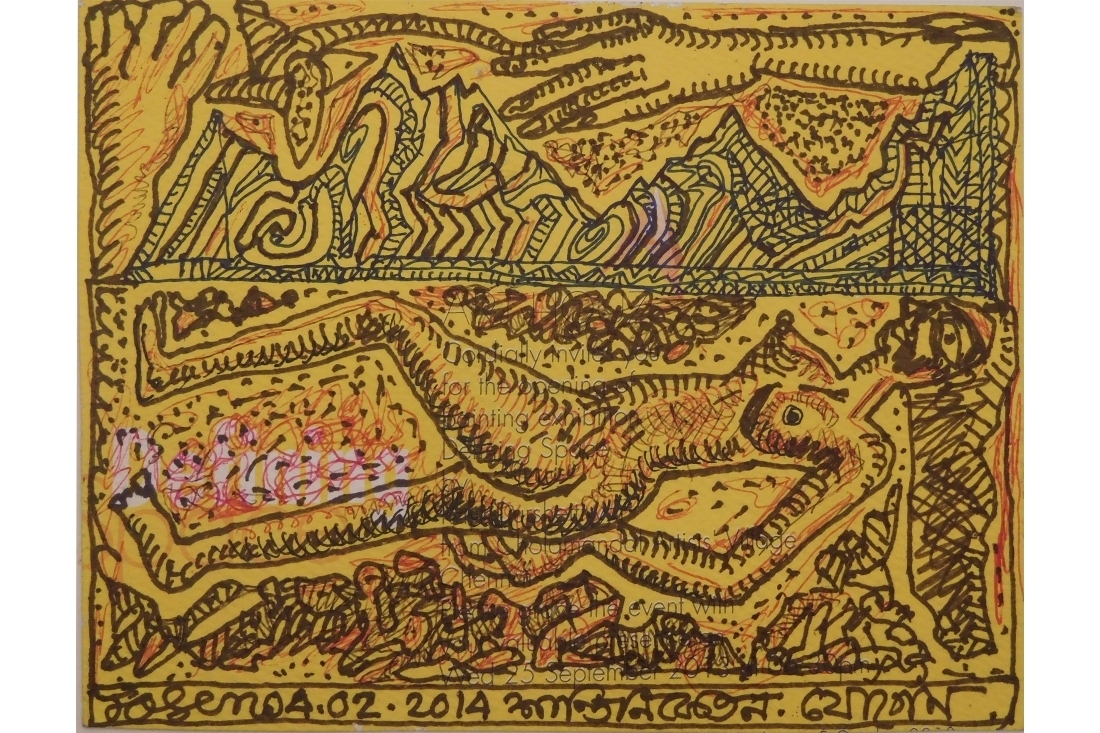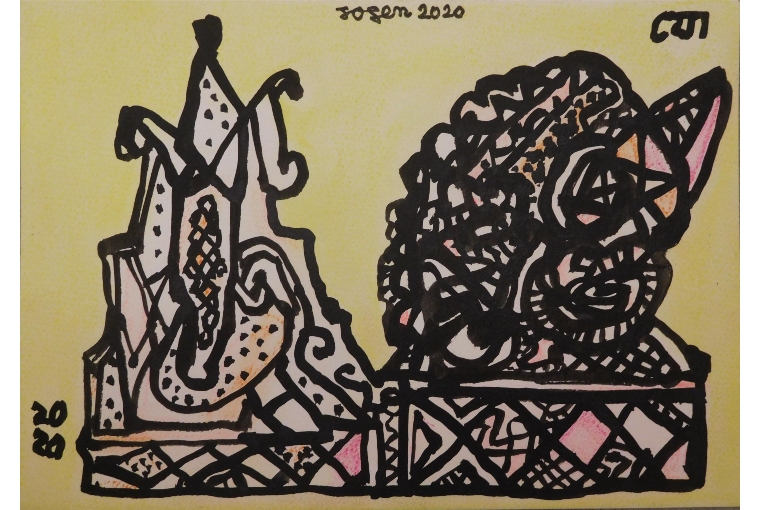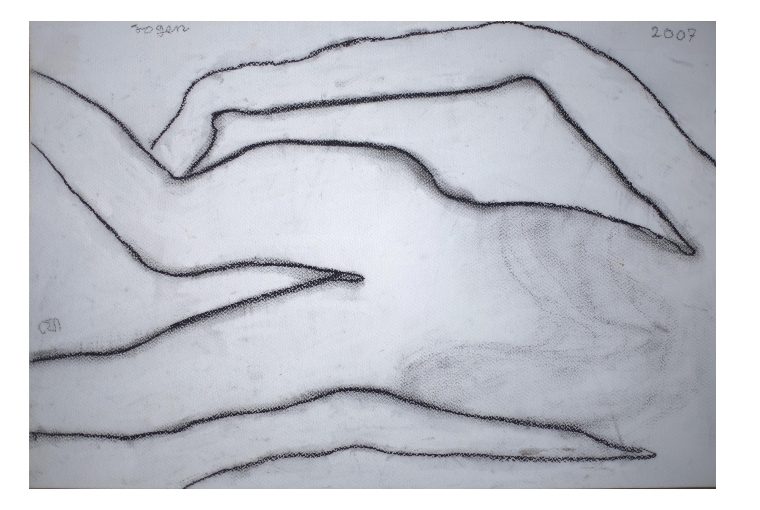
The Woman, Pen & Ink on Paper, 13 x 10 cm, 201

The Woman, Pen & Ink on Paper, 13 x 10 cm, 201
'It is important that objects which are in use day-to-day should be made artistic. This is necessary for the growth of an understanding of art among the public—and people can be exposed to art through them. An object of use, like a bed, a light stand, pots, spoons, textiles, available in most households, may have artistic form, colour, line, etc and can give pleasure to the person who uses and looks at it.’ -- Jogen Chowdhury
The current exhibition with works made through the pandemic months of stillness reiterates what the artist has always expressed about his practice, that the distortion of the painted figure and posture is a deliberate ploy to show the complexity that exists within a man and in his relationship with the environment and the world. Although the intimate portraitures reverberate with sentiments universally felt, Jogen Chowdhury’s narrative belongs without doubt to Bengal and his own identity. He has been deeply impacted by the vicious attacks repeatedly on the minorities and the marginalized in our society and his deep grief finds artistic expression in these works. The recurrent theme of gruesome wounds and mangled limbs portray his agony yet again in the vividly painted images of severed fingers or that of a nude body with a gash across its torso. Disturbing yet riveting, these images are a powerful comment on the recent history of our country, visual narratives that lastingly sear the imagination of the viewer.
Born in 1939, Chowdhury had seen some of the most turbulent periods faced by the nation, in his boyhood and as a young adult but the spiralling violence and political unrest in recent years have left him deeply disturbed. Having spent his earliest years as a refugee, when he accompanied his family from Bangladesh (erstwhile East Pakistan) to Kolkata, during the Partition, he had seen the vast inequalities that existed between the people in rural and urban areas, the divide between classes and different religious groups but there had been the hope that the problem would be resolved, someday. Disillusion and a realization that life would continue with twists and turns and political upheaval, he channelized his angst and anguish through his art, which portrayed the disparities and differences through satire and parody. In his urban narratives, the artist’s ideological choice found expression, becoming hischaracteristic signature. As Frederic Jameson observed, ‘Fabulation-or if you prefer, mythomania and outright tall tales- is no doubt a sign of social and historical impotence, of the blocking of possibilities that leaves little option but the imaginary. Yet its invention and inventiveness endorse creative freedom..’

Temple and the Idol, Brush with Ink & Coloured Pastel Dry, 21 x 29 cm, 2020
As Jogen Chowdhury himself acknowledged, it was at this juncture that he recognized three- dimensionality, with heft or a fall always in motion in his art, when there came an acute consciousness within him, of the process of organic growth, be it in the way he projected the animal or human form or the way here presented the vegetal world in his iconography. Later, when it came to structuring his compositions, both the elements of realism and a luminous decorativeness heightened the dramatic spirit of the work in his drawings and oil paintings, intimate or large. Socio-political satire, as well as allegorical themes, became his focus and human relationships became a part of his oeuvre, the convoluted and twisted equations between individuals. Chowdhury remarks, ‘One of the subjects that have repeatedly occurred in my paintings is the man-woman relationship and the innumerable components surrounding it. I am fascinated with the complexity, the sensitivity and dramatic element it offers.’
In conversations, the artist has spoken often of how personal memories, the hardships faced as a young adult shaped his thinking and how he was able to always find solace in his art. A deeper understanding of his artistic process offered itself when the artist Manjit Bawa (a good friend of Jogenda) and I had visited his studio on our trip to Shantiniketan when Jogen Chowdhury had invited him to show his works at Kala Bhavana. We had been seated on the floor of his Shantiniketan studio, watching him paint ‘shauras’ for Nandan Mela (perhaps in1998) when he began speaking of his formative years, the times when he had to use newsprint to paint on since art material was beyond his reach. The predominance of black that often possessed him, the only colour that allowed him to express his angst.

Reclining Torso, Dry Pastel on Paper, 38 x 56 cm, 2007
It had been a bright winter morning and the windows opened out to his carefully tended garden, radiant with seasonal flowers, but Jogenda had been lost in a reverie. He had been speaking of his approach to portraiture when he explained that beyond the details of the face and expression it was important for him to build up the personality, the total history of the character. In his oeuvre, we had already seen how he could skillfully recreate a known person from memory but there were instances when he made portraits of people he had known intimately and as if to reinforce this point, he had brought out a few portraits painted in his formative years, stacked along with a pile of canvases on the wall. Amongst the works were self-portraits along with paintings the artist had made of family and friends resurrected from memories. It was an unforgettable moment, this glimpse into his past, of people he had known intimately, the earliest studies made skillfully but with touching naiveteÌ, so different from his later oeuvre, the stylized compositions that came to be associated with his name. We had requested to be shown more works and Jogenda had brought out a few more from his collection to show us, derisive compositions of Babus with Gandhi caps, intimate images of couples engaged, as well as striking still life compositions (with flowers vases, fruits, animal figures and so on), all too soon, it was time for us to leave, albeit reluctantly, to set up Manjit’s works for the show. In later years, while there would be other opportunities to see Jogenda’s exhibitions, we would recollect that winter morning with nostalgia, when personal storytelling intertwined with memories had made the experience of looking at his art so enriched.
Jogen Chowdhury will be showing his works from December 18th, with Art Exposure, Kolkata. Unlike larger compositions, these works are small format, created with consummate skill, whether they are minimalistic outlines or intensely textured figures. The paintings/drawings of man, plant and animal life may appear disengaged from any obvious context but they forge a mystical relationship within themselves as if participants of an untold story. To quote the artist, ‘I find a vitality running through trees, flowers, creepers and leaves, and feel it acutely. Mankind, animal life and nature in the form of plant life are all bound to the rhythm of universal nature. This is a notion that has its validation in science. But it is also a notion that surfaced for the first time as a theory in the Upanishads, and reached us in the songs and writings of Rabindranath Tagore.’
The pictures depicting faces of men and women reveal weariness as if the lovers of yesterday are long past their prime and their romance is now like a dried flower discovered between pages of a book of poems. The spirit of an invisible city lurks in the background, unseen but present, the brutal smoke-spewing factories, perhaps, the crowded metropolis heaving with multitudes of people trying to go through the motions of life, in the hope of a better tomorrow. Chowdhury has often drawn inspiration from poetry and it now appears in his painted world as a frame of motifs, the lush flowers, creepers and patterns of ‘alpona’ that counters the images of the searing wounds and brutal lacerations on naked bodies, the terrible desperation in the eyes of the people. The artist is conflicted and subject to different moods as the pandemic rages across the world, there are days of dark depression when it is the ugliness and bleakness that he is drawn to, at other moments, he feels lightness. Like different pages of his calendar, like the nine ‘rasas’, the works in the suite reflect in turns thevarying moods, moving from the dark to hopeful. Poetic fantasy and biting satire are two sides of the coin and seldom has the viewer observed the human form or face expressing such a wide range of emotions. Speaking from Shantiniketan, Jogenda clarified that the works happened organically over time, without specific plan, till Art Exposure invited him, to exhibit.
Looking at the works and the invocation of memory that runs through the works, like a thread, one is reminded of the words of Rainer Maria Rilke, 'For the memories, themselves are not important. Only when they have changed into our very blood, into glance and gesture, and are nameless, no longer to be distinguished from ourselves-only then can it happen that in some very rare hour the first word of a poem arises in their midst and goes forth from them.’
Text Ina Puri
For online viewing : https://artexposure.in